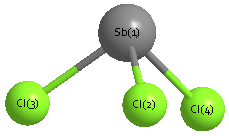Geometric Data

Point Group C3v
Internal coordinates
distances (r) in Å, angles (a) in degrees, dihedrals (d) in degrees
Cartesians
| Atom |
x (Å) |
y (Å) |
z (Å) |
| Sb1 |
0.0000 |
0.0000 |
0.5830 |
| Cl2 |
0.0000 |
2.0207 |
-0.5830 |
| Cl3 |
1.7500 |
-1.0104 |
-0.5830 |
| Cl4 |
-1.7500 |
-1.0104 |
-0.5830 |
Atom - Atom Distances 
Distances in Å
| |
Sb1 |
Cl2 |
Cl3 |
Cl4 |
| Sb1 |
|
2.3330 | 2.3330 | 2.3330 |
| Cl2 |
2.3330 |
|
3.5000 | 3.5000 |
| Cl3 |
2.3330 | 3.5000 |
|
3.5000 |
| Cl4 |
2.3330 | 3.5000 | 3.5000 |
|
Calculated geometries
for SbCl
3 (Antimony Trichloride).
Experimental Bond Angles (degrees) from cartesians 
| atom1 |
atom2 |
atom3 |
angle |
|
atom1 |
atom2 |
atom3 |
angle |
| Cl2 |
Sb1 |
Cl3 |
97.200 |
|
Cl2 |
Sb1 |
Cl4 |
97.200 |
| Cl3 |
Sb1 |
Cl4 |
97.200 |
Bond descriptions
Examples: C-C single bond, C=C, double bond, C#C triple bond, C:C aromatic bond







